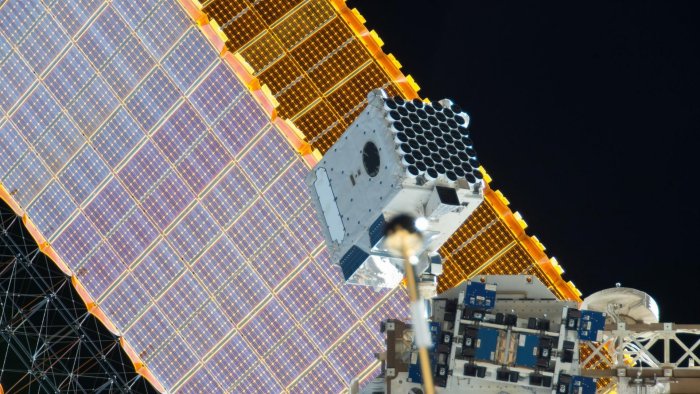Eddie Gonzales Jr. – MessageToEagle.com – The Milky Way holds many secrets. Researchers from DTU have uncovered another one using an X-ray telescope on the ISS.
It is a small but extremely massive and fast-spinning object – a neutron star, part of a so-called ’X-ray binary star system’ named ‘4U 1820-30’. It’s found in the Sagittarius constellation towards the centre of our galaxy.
The neutron star (right) is part of a double system with the catalog name 4U 1820-30. Image credit: NASA
“We were studying thermonuclear explosions from this system and then found remarkable oscillations, suggesting a neutron star spinning around its centre axis at an astounding 716 times per second,” says DTU Space senior scientist Dr Gaurava K. Jaisawal, who is part of an international team of researchers behind the new finding and first author of the paper.
“If future observations confirm this, the 4U 1820-30 neutron star would be one of the fastest-spinning objects ever observed in the universe, matched only by another neutron star called PSR J1748–2446”.
The neutron star was observed using NASA’s NICER X-ray telescope, fitted with star tracker technology from DTU Space and mounted outside of the International Space Station, ISS. The star tracker camera system ensures that the X-ray instrument constantly points in the right direction and correctly aims at the small neutron stars far away in the Milky Way.
A very extreme phenomenon very far away
A neutron star, also called a dead star, consists of the remnant of a large, massive star that has exploded in a supernova. A few thousand of them have been discovered, and they are extreme in pretty many ways.
They are the densest objects that can be observed in the cosmos. The neutron star in question is only 12 km across but has a mass 1.4 times greater than the Sun’s.
It is located 26,000 light years away from Earth. By comparison, the distance to Earth’s nearest star, Proxima Centauri, is about 4.3 light years. This means that light from Proxima Centauri takes 4.3 years to reach us on Earth, while the light from the neutron star travels for 26,000 years before we can observe it on Earth.
The neutron star was observed using NASA’s NICER X-ray telescope, which is mounted on the International Space Station and equipped with star-tracker technology from DTU Space.
The neutron star is part of an X-ray binary star system. Such a system consists of two stars orbiting each other. What is also peculiar with the system ‘4U 1820-30’ is that the companion star is a white dwarf about the same size as the Earth. It is known to orbit the neutron star every 11 minutes, making it the system with the shortest known orbital period.
Surface burst as powerful as an atomic bomb
Due to its intense gravity, the neutron star pulls material away from its companion star. When enough material has accumulated on its surface, a violent thermonuclear burst occurs on the neutron star, similar to an atomic bomb.
“During these bursts, the neutron star becomes up to 100,000 times brighter than the Sun, releasing an immense amount of energy,” explains Associate Professor at DTU Space, Jerome Chenevez, who contributed to the new article in Astrophysical Journal.
“So we are dealing with very extreme events, and by studying them in detail, we get new insights into the exiting life cycles of binary star systems and the formation of elements in the universe”.
Through observations made with NICER between 2017 and 2021, the researchers discovered 15 thermonuclear X-ray bursts from the X-ray binary star system called ’4U 1820-30’. It was one of these bursts that showed a signature known as ‘thermonuclear burst oscillations’, occurring at a frequency of 716 Hz.
These burst oscillations match the spin frequency of the neutron star itself, meaning that it rotates on its axis at a record-high rate of 716 times per second.
Written by Eddie Gonzales Jr. – MessageToEagle.com Staff Writer








